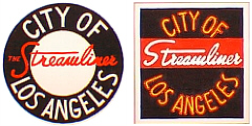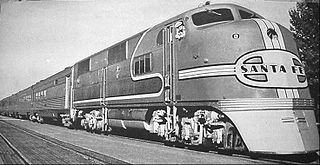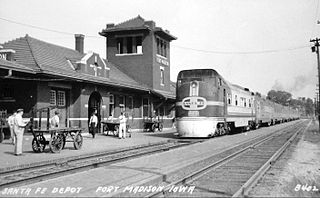
The City of Portland was a named passenger train on the Union Pacific Railroad between Chicago, Illinois, and Portland, Oregon. The first trip left Portland on June 6, 1935, using the streamlined M-10001 trainset. With only one set of equipment, the train left each terminal six times a month. A broken axle derailed the trip that left Chicago on July 23, 1935, and the repaired train resumed service with the trip leaving Portland on February 6, 1936. In May 1936 it started running five times a month instead of six, allowing more time in Chicago between trips.

A streamliner is a vehicle incorporating streamlining in a shape providing reduced air resistance. The term is applied to high-speed railway trainsets of the 1930s to 1950s, and to their successor "bullet trains". Less commonly, the term is applied to fully faired upright and recumbent bicycles. As part of the Streamline Moderne trend, the term was applied to passenger cars, trucks, and other types of light-, medium-, or heavy-duty vehicles, but now vehicle streamlining is so prevalent that it is not an outstanding characteristic. In land speed racing, it is a term applied to the long, slender, custom built, high-speed vehicles with enclosed wheels.

The City of Denver was a streamlined passenger train operated by the Union Pacific Railroad between Chicago, Illinois, and Denver, Colorado. It operated between 1936 and 1971. From 1936–1955 the Chicago and North Western Railway handled the train east of Omaha, Nebraska; the Chicago, Milwaukee, St. Paul and Pacific Railroad handled it thereafter. The train was the fastest long-distance train in the United States when it debuted in 1936, covering 1,048 miles (1,687 km) in 16 hours. For almost its entire career its principal competitor was the Chicago, Burlington and Quincy Railroad's Denver Zephyr. When Amtrak assumed operation of most intercity trains in the United States in 1971, it discontinued the City of Denver, preferring to use the Burlington's route between Chicago and Denver.

The City of Los Angeles was a streamlined passenger train between Chicago, Illinois, and Los Angeles, California via Omaha, Nebraska, and Ogden, Utah. Between Omaha and Los Angeles it ran on the Union Pacific Railroad; east of Omaha it ran on the Chicago and North Western Railway until October 1955 and on the Milwaukee Road thereafter. The train had number 103 westbound and number 104 eastbound.

Illinois Central 121 was a diesel streamliner built in 1936 by Pullman-Standard and powered by Electro-Motive Corporation, which was used by the Illinois Central Railroad on the Green Diamond. Its fixed five-car consist was also the end of an era; the popularity of the early streamliners was their undoing, because the trains could not be lengthened or shortened to handle varying loads. It was the last streamliner built with the power car articulated with the train; future streamliners featured a matched but separable locomotive. The train was painted in a two-tone green livery, "Cypress Green" on the nose and below the window sills with "Cedar Green" above, separated by an aluminum strip. Extensive aluminum trim was applied.

The EMC E2 was an American passenger-train diesel locomotive which as a single unit developed 1,800 horsepower (1,300 kW), from two (2) 900 horsepower (670 kW) prime movers. These locomotives were typically operated as a unit set or ; where the three unit lashup developed 5400 horsepower. This was almost the ideal horsepower required for the tonnage of a 15 - 18 car passenger train, operated over the ruling grades of virtually all of the mileage between major American cities. The units were of the A1A-A1A wheel arrangement, and manufactured by Electro-Motive Corporation (EMC), later Electro-Motive Diesel (EMD) of La Grange, Illinois.

The M-10000 was an early American streamlined passenger trainset that operated for the Union Pacific Railroad from 1934 until 1941. It was the first streamlined passenger train to be delivered in the United States, and the second to enter regular service after the Pioneer Zephyr of the Chicago, Burlington and Quincy Railroad.

The EMC-TA was a model of diesel locomotive produced for the Chicago, Rock Island and Pacific Railroad by the Electro-Motive Corporation in 1937. The original six Rock Island Rockets streamliners were three- or four-car stainless-steel semi-articulated trainsets built by Budd Company, powered by six identical locomotives, #601-606. The locomotives were classified as model TA—the T indicating Twelve hundred hp (890 kW), the A indicating an A unit. The Rock Island Line was EMC's only customer for the TA locomotive model.

EMD E-units were a line of passenger train streamliner diesel locomotives built by the General Motors Electro-Motive Division (EMD) and its predecessor the Electro-Motive Corporation (EMC). Final assembly for all E-units was in La Grange, Illinois. Production ran from May 1937, to December, 1963. The name E-units refers to the model numbers given to each successive type, which all began with E. The E originally stood for eighteen hundred horsepower, the power of the earliest model, but the letter was kept for later models of higher power.

The EMC E1 was an early passenger-train diesel locomotive developing 1,800 hp, with an A1A-A1A wheel arrangement, and manufactured by Electro-Motive Corporation of La Grange, Illinois. They were built during 1937 and 1938 for the Atchison, Topeka and Santa Fe Railway for a new generation of diesel-powered streamlined trains. 8 cab-equipped lead A units and three cabless booster B units were built. The initial three locomotives were AB pairs built to haul the Santa Fe's Super Chief diesel streamliners, while the others were built as single A units to haul shorter trains. The locomotives were diesel-electrics with two 900 hp (670 kW) Winton 201-A engines each, with each engine driving its own generator to power the traction motors. The E1 was the second model in a long line of passenger diesels of similar design known as EMD E-units. All Winton 201A-engined Santa Fe passenger units, including the E1s, were extensively rebuilt into the 80-class E8M engines in 1952–53. These were similar to production E8 models, but derated to 2,000 hp so as not to burn out the early traction (axle) motors.

The EMC EA/EB is an early passenger train-hauling diesel locomotive built from May 16, 1937, to 1938 by Electro-Motive Corporation of La Grange, Illinois for the Baltimore and Ohio Railroad. They were the first model in a long line of passenger diesels of similar design known as EMD E-units. Each locomotive unit developed 1,800 horsepower (1,300 kW) from two 900 hp (670 kW) Winton 201-A diesel engines, driving the wheels through an electric transmission—the generator driven by each engine provided current for traction motors. The locomotives were of A1A-A1A wheel arrangement—two three-axle trucks of which only the outer two axles were powered. Six two-unit 3,600 hp (2,700 kW) locomotives were produced, each consisting of a lead cab-equipped EA A unit and a cabless booster EB B unit. They were numbered 51 through 56; the A units bore the bare number and the B units the number followed by 'X'.

Electro-Motive Corporation produced five 1800 hp B-B experimental passenger train-hauling diesel locomotives in 1935; two company-owned demonstrators, #511 and #512, the Baltimore and Ohio Railroad's #50, and two units for the Atchison, Topeka and Santa Fe Railway, Diesel Locomotive #1. The twin engine power unit layout and multiple unit control systems developed with the B-B locomotives were soon adopted for other locomotives such as the Burlington Route's Zephyr locomotives built by the Budd Company in 1936 and EMC's own EMD E-units introduced in 1937. The B-B locomotives worked as proof-of-concept demonstrators for diesel power with the service loads of full size trains, breaking out of its niche powering the smaller custom Streamliners.

The General Pershing Zephyr was the ninth of the Chicago, Burlington & Quincy Railroad's Zephyr streamliners, and the last built as an integrated streamliner rather than a train hauled by an EMD E-unit diesel locomotive. It was constructed in 1939 with bodywork and passenger cars by Budd Company and diesel engine, electric transmission, power truck, and other locomotive equipment by General Motors Electro-Motive Corporation. Because its intended Kansas City to St Louis route passed near the birthplace and boyhood home of famous World War I General John J. Pershing, the train was named after him. The power car was named Silver Charger, after Pershing's horse Charger, while the passenger cars were named after United States Army badges of rank—Silver Leaf, Silver Eagle, and Silver Star.

The Union Pacific Railroad's M-10001 was a diesel-electric streamlined train built in 1934 by Pullman-Standard with a power system developed by General Motors Electro-Motive Corporation using a Winton 201A Diesel engine and General Electric generator, control equipment and traction motors. It was the UP's second streamliner after the M-10000, their first equipped with a diesel engine and was a longer train than its three-car predecessor. All cars were articulated—trucks were shared between each car. It was delivered on October 2, 1934, and was used for display, test and record-setting runs for the next two months before being returned to Pullman-Standard for an increase in power and capacity, following which it was placed into service as the City of Portland train. It has been nicknamed "The Banana".

The Union Pacific Railroad's M-10003, M-10004, M-10005, and M-10006 were four identical streamlined 2-car power car diesel-electric train sets delivered in May, June, and July 1936 from Pullman-Standard, with prime movers from the Winton Engine Corporation of General Motors and General Electric generators, control equipment and traction motors. One was for the City of San Francisco, two were for the City of Denver, and one was a spare set intended for both routes. In 1939, M-10004 was split and converted into additional boosters for the other sets, now renumbered CD-05, CD-06, and CD-07, all running on the City of Denver. The M-10001 power car became the other third booster. In this form, the three power sets ran until they were replaced by E8 locomotives in 1953, at which point they were scrapped.
Early Electro-Motive Corporation switcher locomotives were built with Winton 201-A engines. A total of 175 were built between February 1935 and January 1939. Two main series of locomotives were built, distinguished by engine size and output: the straight-8, 600 hp (450 kW) 'S' series, and the V12, 900 hp (670 kW) 'N' series. Both were offered with either one-piece cast underframes from General Steel Castings of Granite City, Illinois, denoted by 'C' after the power identifier, and fabricated, welded underframes built by EMC themselves, denoted by 'W'. This gave four model series: SC, SW, NC and NW. Further developments of the 900 hp (670 kW) models gave model numbers NC1, NC2, NW1, and NW1A, all of which were practically indistinguishable externally from the others, as well as a pair of unique NW4 models for the Missouri Pacific Railroad and a solitary, twin-engined T transfer locomotive model built for the Illinois Central Railroad.

The Pioneer Zephyr is a diesel-powered trainset built by the Budd Company in 1934 for the Chicago, Burlington & Quincy Railroad (CB&Q), commonly known as the Burlington Route. The trainset was the second internal combustion-powered streamliner built for mainline service in the United States, the first such train powered by a diesel engine, and the first to enter revenue service.

The Royal Blue was the Baltimore and Ohio Railroad (B&O)'s flagship passenger train between New York City and Washington, D.C., in the United States, beginning in 1890. The Baltimore-based B&O also used the name between 1890 and 1917 for its improved passenger service between New York and Washington, collectively dubbed the Royal Blue Line. Using variants such as the Royal Limited and Royal Special for individual Royal Blue trains, the B&O operated the service in partnership with the Reading Railroad and the Central Railroad of New Jersey. Principal intermediate cities served were Philadelphia, Wilmington, and Baltimore. Later, as Europe reeled from the carnage of World War I and connotations of European royalty fell into disfavor, the B&O discreetly omitted the sobriquet Royal Blue Line from its New York passenger service and the Royal Blue disappeared from B&O timetables. Beginning in 1917, former Royal Blue Line trains were renamed: the Royal Limited, for example, became the National Limited, continuing west from Washington to St. Louis via Cincinnati. During the Depression, the B&O hearkened back to the halcyon pre-World War I era when it launched a re-christened Royal Blue train between New York and Washington in 1935. The B&O finally discontinued all passenger service north of Baltimore on April 26, 1958, including the Royal Blue.


















